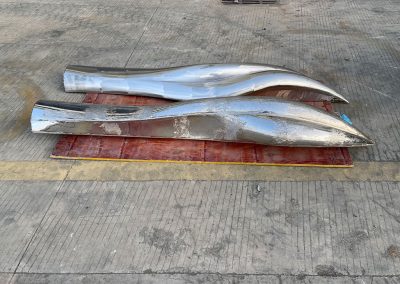He is installing two flange bearings on a small platform inside the sculpture’s base. Each bearing has a flange base with a bearing inside and a collar on top. The bearing has a grease zerk fitting for lubrication. The collar has a couple of set screws in it to hold the shaft in place.
Why use two bearings? Kevin shows how much play there is when using a single bearing, then slides the shaft down through the first one into the second bearing, tightening up the set screws on both, to show much of a difference it makes. Using two bearings allows one bearing to cancel out the movement of the other. The side-to-side movement goes away.
The door in the base allows Kevin to more easily install the plate inside the pedestal that the bearings are attached to. Otherwise, he would have had to reach all the way up from the bottom and try to level and weld the platform without being able to see it.
The door also makes it easier to remove the bearings for powder coating and to grease the bearings as well as to replace them as necessary.
Kevin tightens the bolts and shows, except for a little flex in the shaft itself, everything stays nice and straight, and the sculpture spins smoothly. He still needs to grease the bearings to make it spin even more easily.
He’ll finish off the top of the pedestal by cutting three pieces of metal and welding them on at a slight slope with a hole for the shaft. Then he’ll add the tabs, the door, and get some countersunk screws so no one will even notice the inspection door. He’ll also add a little trim just to dress up the bottom of the pedestal.
Then he’ll remove the bearings and send the pedestal, door and screws off to the powder coater. Meanwhile, he’ll shine up the copper, then clear coat it so it stays shiny.

